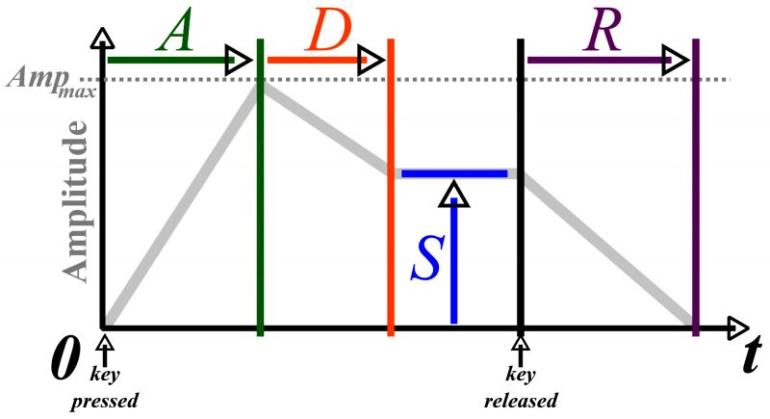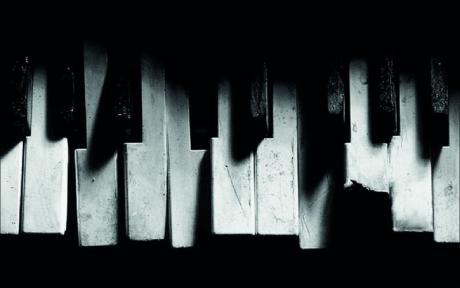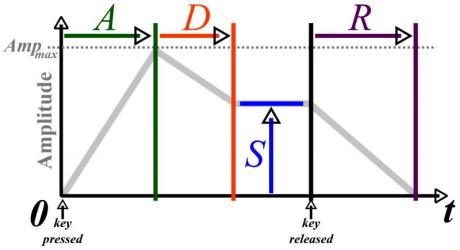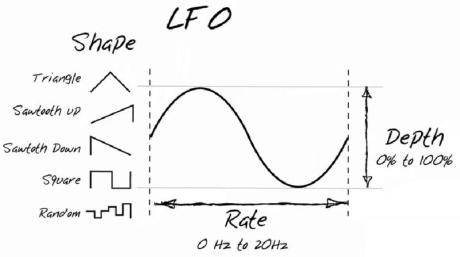Rockové klávesy - Analogová syntéza zvuku od základu - část 3.

Analogová syntéza - Volume Envelope and LFO - část 3.
Hi, Everyone! Welcome to our last installment of our three part in depth look at analog synthesis. In part one we spoke a little bit about classic analog synths and I explained the different types of waveforms. In part 2, last month, we discussed all the different types of filters. In this last installment, I want to speak about the shape of the sound as expressed by the loudness contour, or as it's more commonly known, the volume envelope. This last facet of analog sound production determines the volume of the patch and plays an essential part in giving a sound its own individual character. Let me give you a few short examples of different volume envelopes so you get the idea. Lets look at the envelope for an organ sound; a typical organ patch sounds immediately when the key is struck and sustains for as long as the note is held. On most organs, the sound dies away immediately when it is released. The volume envelope of a piano patch is a little different. The sound starts as soon as you strike a note but slowly dies away even if the note is held. As you can see, the envelope has a big effect of the sound. Lets take a closer look at the four different stages a sound goes through as it's envelope is shaped:
Attack: This is the length of time required for the sound to reach its initial maximum volume. If we have a snare drum hit, it is said to have a very fast attack, because the sound goes to maximum volume as soon as it starts. A synth pad, by contrast, can have a very slow attack meaning that it takes a little while to reach it's full volume.

Decay: This stage refers to the time it takes from the initial volume to reach the second volume level known as sustain.
Sustain: This is the volume level the sound plays at as the key is held. It is usually slightly lower than the attack volume but can be at any level. This phase can last forever if you keep on holding the key down
Release: This is the time it takes the volume to reach zero after the key is releases. the longer this value is, the longer the sound will take to die away after the key is released. For example, a stabby brass sound will probably have an immediate release while an airy synth pad might have a much longer release time.
Just so you know, a sound doesn't have to have to go through all four phases. A woodblock, for example only has only an attack and a decay phase. An organ sound has an attack phase, a sustain phase and a release phase but no decay phase.
The beauty of the controls on the old analog synths is that all these parameters that we've been talking about are very changeable in real time. Lets say you start with a short saw tooth wave sound and want to morph into a gentle square wave pad. The first thing you could do is switch the waveform to square. Remember from the first part of our series that the sawtooth waveform actually looks like the teeth of a saw and a square wave looks like 3 sides of a square. These shapes will probably be pictured on the waveform selector switch. push the tab to square and then move your attention to the volume envelope. Our original sound probably has a very short attack and release, so the first thing to do to go to a pad like sound is to make the attack and release time longer. The decay and sustain controls will affect the sound as it travels to completion so experiment with putting these at different values also.

Low Frequency Oscillator
The last part of analog synthesis we speak about will be the Low Frequency Oscillator. A LFO, as it is commonly abbreviated, is an oscillator that vibrates at an extremely low frequency creating a pitch shifting vibrato that effects the sound in various ways. The shapes of the wave forms that govern this effect are usually very similar, if not the same, as the oscillators that make the sound waveforms. The LFO section on an analog synth usually has three main parts; waveform, which we just spoke about, frequency, which correlates to how fast the LFO will operate and depth, which determines the amplitude of the wave. As we touched on before, the different waveforms will produce different sonic effects. Let's take a look at some of these waveforms and the way they change the sound. You will recognize many of the names.
Sine: With this waveform, the selected pitch will rise and fall evenly. At low levels this will sound like a mild vibrato. As the intensity increases a siren sound will be produced
Square: This wave makes the sound oscillate between two pitches. Unlike the Sine wave, there is a break in the sound as it goes between the pitches.
Triangle: Triangle can be said to sound in between the two above mentioned waves. It does tend to "lean to one side" a bit as the waveform is not as even. Check out this video to hear this difficult to describe wave:
www.youtube.com/watch?v=yZ59iJltAcg
Noise: This wave sounds like distortion is being added to the sound. It can sound like a bit crusher too as the level of the LFO is increased. Here's a link with an example of a LFO noise wave:
www.youtube.com/watch?v=N_mpAdJdKGQ
S&H: This is actually my favorite wave form. S & H which means sample an hold causes the sound to jump around on a seemingly random set of pitches. Interesting melodic fragments arer automatically created and are synced in time to the rate of the oscillator. I also like to add this in real time as I'm playing a solo. it sounds like you are playing interesting lines outside the key.
In closing, I believe it's essential to have some sort of analog keyboard or analog soft synth in your rig. The realtime control of these synths makes complicated sonic soundscapes a breeze. There's a reason most genres of modern electronic music still rely so heavily on these synths. Search online, there are lots of cool freeware synths that you can download and use on your laptop. One of my favorites companies for these free plug ins is U-He:
Loudness contour: Jak píše Brian ve svém článku, tento výraz je ekvivalentní pojmu „volume envelope“, který se někdy v muzikantském žargonu překládá poněkud otrocky jako „obálka“. Já vás však chci především upozornit na slovo „contour“, které se v hudbě používá v různých významech, takže může dojít k nedorozumění. Někdy se totiž setkáme s tímto výrazem u určitých typů ekvalizérů, kdy takto nazvaný parametr ovládá celkovou „ostrost“ nebo zabarvení. Nemusím jistě vysvětlovat, že v tomto článku „contour“ nic společného s ekvalizérem nemá. Jedná se o křivku průběhu hlasitosti tónu.
Patch: Uložené uživatelské nastavení (např. jeden konkrétní klávesový zvuk či rejstřík). Toto slovo občas poněkud nešťastně splývá s pojmem „preset“, který však často znamená spíše nějaká nastavení, s kterými přístroj přišel již z výroby (tedy přesněji „factory preset“). Je proto jako vždy potřeba sledovat kontext, aby nedošlo k nedorozumění. Mnohoznačnost slov bude tak trochu ústředním motivem tohoto glosáře.
Pad: Opět pozor na kontext. I v rámci klávesových nástrojů může toto slovo znamenat různé věci. Pokud mluvíme o zvuku syntezátoru, většinou se takto označuje rejstřík, který má za cíl vyplnit skladbu táhlými akordy na pozadí. Klávesové kontroléry ale často mají i jiné „pady“: gumové plošky, které lze použít ke spouštění samplů, smyček apod.
Phase: V tomto článku je slovo používáno ve smyslu „etapa“, ale často na něj narazíme také ve významu „fáze signálu“.
Sustain: I u tohoto slova chci varovat před mnohoznačností. U některých nástrojů se používá ve smyslu „doba, než tón odezní“, zatímco u syntezátoru se jedná o hlasitost, kterou si tón drží až do uvolnění klávesy.
Stabby: Adjektivum, které znamená něco jako „hraný s výrazným staccatem“.
Airy: Vzdušný, nadýchaný, éterický zvuk. No řekněte, nepůsobí to někdy komicky, když se snažíme popsat zvuk slovy?
Bit crusher: Digitální efekt, který dociluje specifického zkreslení tak, že záměrně snižuje vzorkovací frekvenci nebo bitovou hloubku (často obojí). Výsledek je značně lo-fi, což může být někdy žádoucí.
Sample and hold: Přestože většina z nás si spojuje slovo „sample“ výhradně s digitálním světem, tuto techniku nabízely již prastaré analogové syntezátory. Uchovat si určité napětí (a tedy jej „navzorkovat“) totiž po určitou dobu umí i kondenzátor, čehož lze využít právě např. v analogové syntéze, jak Brian popisuje v samotném článku.
Soundscapes: Když skombinujete slovo „sound“ a „landscape“ (krajina), získáte „soundscape“. Někdy takto označujeme mnohovrstevnaté, až „třírozměrně“ znějící zvuky, obzvláště pak elektronického původu.





